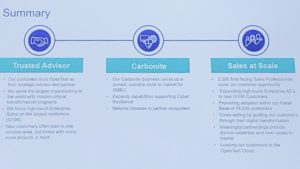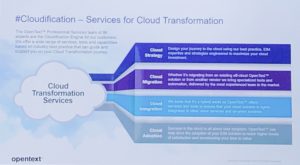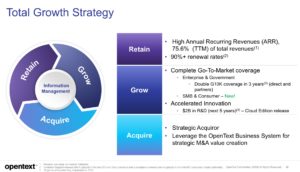We started the second day of the OpenText analyst summit with EVP of sales Ted Harrison outlining their sales value proposition, both through their direct sales force and their partner channel. Customers tend to start with one OpenText product, but often expand to additional product lines to create more of a strategic partnership. OpenText is a prolific user of their own technology, providing a good template for some of their large customers in how their products can be used throughout an organization. With the growth in their cloud platform, they expect cloud to be their largest business in FY21. Harrison finished his presentation with a couple of customer case studies: Pacific Life doing a huge migration to OpenText Cloud, and JPMorgan Chase using AI for automated redaction, and Google using TeamSite for their partner portal.
James McGourlay, EVP of customer operations, covered their support, professional services and customer experience teams. They’ve done more than 40,000 engagements, which has created a depth of knowledge in successful deployment of their products. To fuel the move to the OpenText Cloud, professional services is helping customers with “Cloudification” strategy, migration, integration and adoption. McGourlay spoke about their commitment to data sovereignty, especially for European customers that have strict location regulations for certain data types. They perform customer satisfaction surveys for both professional services and technical support, with the goal to constantly improve their approval rating — currently at 96.4% for their technical support, for example, which he considers “not good enough”.
The last presentation in this session was CFO Madhu Ranganathan with a business and financial update. You can get more of the investor and financial details on their website (or read something written by one of the many blue-suited financial analysts in the audience), and she provided a summary of that publicly-available information: profitable and cash flow-positive, 25+ years of solid performance, and a proven M&A track record which is their dominant growth strategy. They have specific criteria for acquisitions: market leadership, value for OpenText’s customers, mission-critical capabilities, financially compelling, larger customer base, and longer operating history. Ranganathan showed a timeline of successful acquisitions; interestingly, none of the three BPM/workflow buys (Global360 and Metastorm in 2011, Cordys in 2013) were mentioned. It’s probably fair to say that workflow is not a primary product category for OpenText; it’s really just functionality within their AppWorks application development platform, most often used content-centric applications such as document lifecycle and case management. In summary, OpenText is solid financially, and has cash in the bank to leverage more acquisitions as part of their growth strategy.



